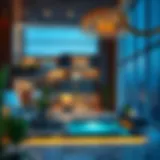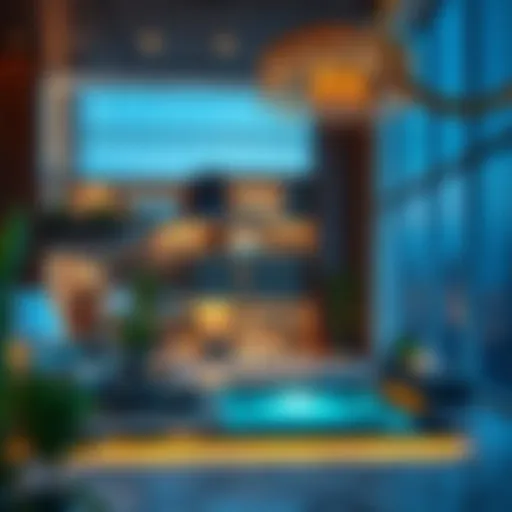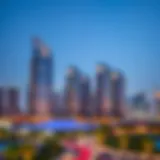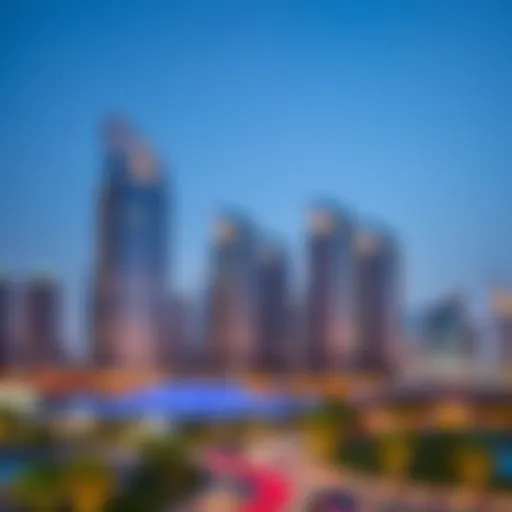The Rich Heritage of the Old Dubai Market


Intro
The Old Dubai Market, often referred to as the heart of Dubai's rich cultural tapestry, has evolved significantly over the decades. Initially, it served as a marketplace where locals would trade spices, textiles, and various artisanal crafts. Nowadays, this spirited locale is a melting pot for both tourists and residents, offering a glimpse into the region's traditional heritage. In this article, we will take a closer look at the market’s historical importance, its transformation over time, and how it continues to hold relevance for today’s economy and tourism sector.
Property Trends in Dubai
Dubai is no longer just a desert city with skyscapers; it has emerged as a global hub for commerce and tourism. The Old Dubai Market, with its vibrant atmosphere, plays a crucial role in showcasing these trends.
Emerging Neighborhoods and Hotspots
In recent years, neighborhoods surrounding the Old Dubai Market, such as Deira and Bur Dubai, have witnessed a resurgence in interest. These areas are now becoming attractive to both homebuyers and investors. With a mix of traditional Arabic architecture and modern amenities, they are ideal for those wishing to immerse themselves in a rich cultural experience.
- Deira: Known for its bustling souks, Deira has become a favorite for investors seeking properties that promise high foot traffic.
- Bur Dubai: Renowned for its vibrant arts scene, this neighborhood has also evolved into a sought-after location due to the blend of modern and historic attractions.
Market Analysis and Future Predictions
A deeper look into the real estate market around the Old Dubai Market reveals promising trends. Analysts predict a steady growth trajectory, fueled by increased tourist interest and ongoing urban development.
"The real estate landscape around the Old Dubai Market is not just about properties; it's about investments in culture and heritage."
As new developments emerge, integrating local themes and sustainability, investors are encouraged to consider properties that not only yield returns but also enrich the community fabric.
Investment Opportunities
For those eyeing the Old Dubai Market area, various investment opportunities can be tapped into. Real estate gurus note that understanding the nuances of the market can lead to informed decisions.
High-ROI Property Types
Investors have a plethora of options to consider when it comes to investment in and around the Old Dubai Market. Some of the high-return property types include:
- Residential Units: With the ongoing interest from expatriates and tourists, serviced apartments and short-term rental units can promise high returns.
- Commercial Properties: Spaces that can accommodate retail shops or restaurants are in high demand, capitalizing on foot traffic from both locals and visitors.
- Mixed-Use Developments: Real estate projects that blend residential, retail, and entertainment options are increasingly popular, linking living spaces with conveniences.
Financing and Mortgage Options
Navigating financing options can be a bit tricky, but it’s manageable. Potential investors should be aware of local banks and their offerings.
- Conventional Mortgages: Many local banks offer competitive rates tailored for expatriates and citizens alike.
- Mortgage Brokers: Engaging with brokers who specialize in Dubai property can open pathways to better financing options for prospective buyers.
As the Old Dubai Market continues to thrive amidst modernity and tradition, savvy investors, agents, and developers are poised to capitalize on its enduring significance in the economic landscape.
Historical Context of the Old Dubai Market
Understanding the historical context of the Old Dubai Market is crucial to grasping its significance within not only Dubai’s cultural fabric but also its economic tapestry. This marketplace has been a trading hub for generations, acting as a reflection of the region's past while also adapting to contemporary demands. As the city transitioned from a quiet fishing village to a bustling metropolis, the market served as a nexus of commerce, culture, and interaction among diverse communities.
Origins and Development
The genesis of the Old Dubai Market can be traced back to the early 20th century when traders, primarily from the Gulf region, settled in Dubai looking for opportunities in trade. The initial market activities centered around traditional goods such as pearls, textiles, and spices. This was a time when Dubai was still evolving, with many travelers passing through on their way to more established trading routes.
As time moved on, the market evolved. It integrated various cultural influences, highlighting Dubai's role as a melting pot for different peoples and customs. Notably, with the discovery of oil in the late 1960s, the market experienced significant expansion. The influx of wealth transformed its layout and offerings, shifting from primarily local goods to a broader range of products that appealed to an increasingly diverse clientele. The Old Dubai Market became not just a center of commerce but a social hub where people gathered to exchange stories, ideas, and goods.
Cultural Significance
The cultural importance of the Old Dubai Market cannot be understated. It stands as a testament to the resilience and adaptability of the local community, showcasing traditions that have persisted despite the rapid modernization surrounding it. The market is more than just a collection of shops; it embodies the spirit of Dubai’s heritage.
Local artisans and merchants still engage in traditional practices, such as handmade crafts and original spice blends, attracting visitors eager to experience authentic Emirati culture. Furthermore, festivals and events regularly hosted within the market amplify its cultural relevance, bringing together communities while promoting local traditions.
"The Old Dubai Market is an enduring symbol of the region's rich past, reminding us of the journey Dubai has undertaken, from a modest trading post to a global city."
Both residents and tourists alike are drawn to the market for its vibrant atmosphere, offering a glimpse into the city's historical identity. For many, it’s a cherished landmark—the heart of a bustling city thriving on the very interactions once held in its alleys. The juxtaposition of the old and new, tangible in the marketplace’s atmosphere, renders it a key player in preserving cultural narratives.
In summary, the historical context of the Old Dubai Market is multifaceted, entwining commerce with cultural heritage. The evolution of the market reflects broader economic shifts while simultaneously safeguarding local traditions. To comprehend its current role in Dubai's landscape, one must first appreciate this rich tapestry of history.
Architectural Features
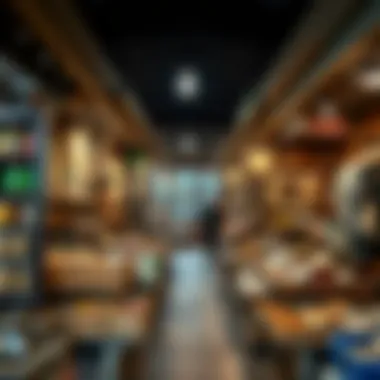

The architectural features of the Old Dubai Market play a crucial role in encapsulating the essence of its historical significance. Visitors are not only drawn to the variety of goods but also to the striking visual characteristics that tell the market's story. The blend of traditional and modern elements illustrates how architecture can serve not merely as a backdrop, but as a poignant expression of culture and identity.
Traditional Design Elements
Historically, the Old Dubai Market's design elements reflect the rich cultural heritage of the region. The architecture predominantly showcases Arabian influences, characterized by wind towers (known as badgirs) that naturally ventilate buildings, keeping them cool in the scorching desert heat. These towers were ingeniously designed to catch even the slightest breeze, showcasing an early understanding of sustainable living.
Buildings often feature mashrabiya, intricately carved wooden latticework that allows for privacy while providing airflow. The arches and domes are a nod to Islamic architecture, portraying an aesthetic sensibility that has stood the test of time. The cohesive layout of the market, with narrow alleyways winding between stalls, echoes the traditional souk design—allowing a sense of intimacy and discovery.
"The architectural charm of the Old Dubai Market is a testament to its resilience and ability to adapt through changing tides."
Moreover, the use of local materials such as coral, stone, and clay reflects an understanding of the environment and available resources. This characteristic not only grounds the market in its geographical context but also enhances its historical narrative.
Modern Enhancements
In recent years, the Old Dubai Market has undergone several modern enhancements that respect its historical integrity while embracing contemporary needs. New lighting systems, for instance, highlight the distinct architectural features without overshadowing their traditional roots. Additionally, upgraded pathways provide better accessibility for visitors, allowing all to experience the market's allure without hindrance.
There's a delicate balance at play—modern architecture strives to instill a sense of freshness while maintaining respect for the past. Some shops have adopted modern facades that still nod to traditional aesthetics, blending glass and steel with age-old design sensibilities.
Urban planners have also incorporated modern amenities seamlessly into the fabric of the market. This includes well-placed seating areas that encourage social interaction and rest, enhancing the overall visitor experience.
As investors look towards redevelopment opportunities, it is vital to consider how these modern enhancements can coexist with the market's original charm. Navigating this balance will be fundamental in preserving the cultural storytelling that the Old Dubai Market provides.
In summary, the architectural features of the Old Dubai Market not only enhance its physical space but also enrich its narrative, making it a significant focal point in the exploration of Dubai's historical and cultural dimensions.
Economic Role in Dubai
The Old Dubai Market has historically stood as a keystone of the economic landscape in the region. Not only does it serve as a bustling hub for local commerce, but it also plays a crucial role in attracting tourists and investors alike. This dual function significantly contributes to the overall vitality of Dubai's economy. As the city has evolved into a global metropolis, the market continues to reflect the economic synergy that defines the area.
Local Commerce
At the heart of local commerce, the Old Dubai Market is a vibrant tapestry of trade and exchange. From textiles to spices, this bazaar breathes life into the entrepreneurial spirit that characterizes Dubai. Small businesses thrive in this environment where merchants, many of whom are family-run, display a dazzling array of products. Each stall is a microcosm of culture, showcasing traditional artifacts and modern wares alike.
Merchants here cultivate relationships, not just transactions. This fosters a sense of community and sustainability, allowing businesses to flourish amidst the competition. Notably, the flexibility of market offerings keeps it relevant. For instance, many businesses have incorporated e-commerce to accommodate a broader audience while maintaining their local roots. The adaptive strategies employed by merchants highlight the market’s resilience in a rapidly changing economic landscape.
Moreover, the market acts as an incubator for aspiring entrepreneurs. Local artisans and craftsmen often set up shop here, benefiting from the market's foot traffic and historical legacy. As consumers increasingly seek unique, handcrafted items, the Old Dubai Market serves as a vital platform for showcasing local talent. Community events and festivals are often held to promote these artisans, further strengthening ties and driving local economic activity.
Impact on Tourism
The impact on tourism is undeniable. The Old Dubai Market attracts millions of visitors from around the world who are eager to experience its rich heritage. Travelers are drawn not only to the lure of shopping but also to the authenticity and cultural experiences it offers. As they wander through the narrow alleyways, they get enveloped in an atmosphere that blends historic charm with modern vibrancy.
Tourism contributes significantly to Dubai's economy, with the Old Dubai Market playing a pivotal role in this sector. Unlike sterile shopping malls, the market offers travelers a taste of local life, allowing for interactions with vendors and other tourists.
"The Old Dubai Market serves as a vivid reminder of the city's past, while still being relevant to today’s global economy."
Business owners have adeptly leveraged this influx of tourists to introduce targeted marketing strategies. For example, shops feature signage in multiple languages and offer special promotions to cater to international visitors. Many establishments even embrace social media to showcase their offerings, such as unique culinary experiences or traditional crafts.
Market Offerings
The Old Dubai Market serves not just as a shopping destination but as a living museum of Dubai's rich cultural tapestry. Understanding the market offerings is essential for investors, agents, homeowners, developers, and planners alike. This section unfolds the diverse elements and experiences that make this marketplace a hub of activity and community engagement. From unique products to immersive cultural experiences, the marketplace is an engine that drives both local commerce and tourism.
Souks and Their Products
The souks are the beating heart of the Old Dubai Market, offering a variety of products that reflect the region's heritage. Each souk showcases distinct merchandise, which often have deep-rooted significance. For instance:
- Spice Souk: The air rich with fragrances, the Spice Souk invites visitors to explore aisles brimming with vibrant spices from around the world. Notable products include saffron, cardamom, and sumac. Here you can find spices used in both traditional and modern culinary practices.
- Gold Souk: This souk dazzles with its brilliant array of gold jewelry. The Gold Souk provides not just products, but a chance to experience the tradition of gold trading, which is both a form of investment and a cultural emblem. Intricate designs speak to the artistic heritage of the region.
- Textile Souk: Vibrantly colored fabrics whisper stories of craftsmanship. The Textile Souk offers silk, cotton, and various cotton blends from countries like India and Pakistan. This place is not just about fabric but also a hub where ideas of fashion and utility converge.
The importance of these products goes beyond commerce; they embody a way of life that is interconnected with Dubai’s historical trading routes. Merchants often eagerly share stories about their products, fostering a sense of community and historical continuity.
Dining and Cultural Experiences
Dining within the Old Dubai Market offers much more than mere sustenance. It serves as an immersive invitation into the culinary traditions and local flavors of the Emirati culture. Visitors can indulge in:
- Traditional Emirati Cuisine: Restaurants and street food vendors offer dishes like Al Harees and Shawarma. These culinary delights are prepared with care and often come with rich histories, showcasing authentic flavors.
- Cafés and Tea Houses: Relaxing in a local café presents the opportunity to enjoy a cup of Arabic coffee, often accompanied by dates. These spaces invite storytelling and socialization, pivotal in Middle Eastern culture.
- Cultural Events: The market regularly hosts cultural events, including music performances and art exhibitions, providing an authentic platform for the local arts scene. Such gatherings not only enhance the visitor experience but also enrich community bonds.
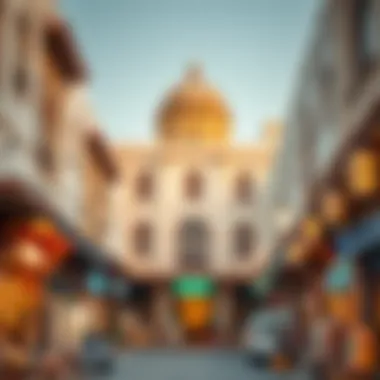

In summary, the offerings of the Old Dubai Market do more than fulfill shopping needs; they provide a crossroads of commerce and culture, allowing for an experience that encompasses the essence of Dubai itself.
"The Old Dubai Market isn’t just a place to shop; it’s where tradition meets modernity, creating unique values for both locals and visitors."
Overall, the market offers a crucial blend of economic potential and cultural richness that appeals to visitors and serves as a point of interest for potential investors.
Visitor Experience
The visitor experience at the Old Dubai Market is a tapestry woven from the threads of culture, history, and the vibrant energy that defines this iconic location. As a key attraction in Dubai, it serves not only as a shopping destination but also as a portal to the past, where traditional practices meet the hustle of modern times. Understanding this experience means grasping how visitors engage with the market and what elements contribute to their overall enjoyment and satisfaction.
Navigating the Market
Wandering through the Old Dubai Market can feel like diving into a treasure trove. But it’s helpful to have a map or, at least, a good sense of direction. The market is quite labyrinthine – you can easily lose yourself among the narrow alleys filled with colorful stalls. Certain areas, like the Spice Souk and Gold Souk, stand out, but it’s wise to roam freely and discover hidden gems along the way.
- Tips for Navigation:
- Start Early: To beat the crowd and feel the morning vibe.
- Ask for Directions: Locals are often friendly and willing to help.
- Landmarks: Keep an eye out for recognizable sites like the old mosque, helping you regain your bearings.
To further enhance the experience, consider engaging with local merchants. They usually have a story to share about the items they sell, whether it’s a handwoven rug or rare spices. Don't hesitate to haggle; it’s part of the game, and you might just walk away with a superior bargain.
Cultural Etiquette
Understanding cultural etiquette is paramount when visiting the Old Dubai Market. Respect for local customs goes a long way to ensure a smooth experience and foster good relationships.
- Dress Modestly: While Dubai is a cosmopolitan city, the market holds a touch of tradition. It’s advisable to cover shoulders and knees.
- Greeting Locals: A simple "Salam Alaikum" (peace be upon you) can break the ice and often elicit warm smiles in return.
- Photography Considerations: Always ask permission before snapping photos of people or their stalls. Some may prefer to keep their wares more private.
"Embracing the local culture not only enriches one’s experience but also shows respect for the place being visited."
Adhering to these etiquette points ensures that visitors leave a positive impression on the locals, fostering an environment that embraces and welcomes others. Ultimately, enhancing the visitor experience in the Old Dubai Market is about immersing oneself in its vibrant culture while remaining cognizant of the nuances that make this space unique.
Every stroll through this market is layered with stories, lessons, and the subtle art of barter, making it more than just a shopping trip, but an adventure of the senses.
Investment Opportunities
The Old Dubai Market represents a thriving hub that brims with potential for investment. For those considering entering this unique locale, understanding the multifaceted opportunities is paramount. With the market's rich cultural backdrop and its evolving nature, investors can find valuable prospects in both commercial and residential sectors. This section outlines the critical components, benefits, and considerations regarding investment opportunities within the Old Dubai Market.
Commercial Ventures
When we delve into commercial ventures, one can't help but notice the vibrant mix of retailers and traders that makes the Old Dubai Market tick. The market isn't just a place to shop; it embodies a thriving vein of economic activity. Investors can tap into this dynamic environment by:
- Opening shops or stalls: A variety of retail options from textiles to spices to handicrafts attract both locals and tourists.
- Establishing dining experiences: Restaurants and cafes that offer traditional Emirati cuisine can capitalize on both foot traffic and the notable dining culture present in the area.
- Commercial partnerships: Aligning with local artisans and suppliers ensures a unique selling proposition that caters to the market's demographic.
Diving into these commercial avenues not only offers the chance for profit but also fosters community ties. There is a solid appeal for investors looking towards the future, especially as the market undergoes continual redevelopment while preserving its historical essence. Each new venture contributes to maintaining the continuum between Dubai’s past and its bright future.
Residential Developments
Residential developments in the vicinity of the Old Dubai Market indicate another intriguing area for investment. With the influx of both tourists and expatriates, housing demands are on the rise. Here are a few insightful points:
- Proximity to the Market: Living close to the bustling market offers convenient access to shopping, dining, and cultural experiences, making residential properties highly desirable.
- Community Living Spaces: Developing apartments or mixed-use buildings that incorporate shops can cater to modern living while staying true to the Old Dubai charm.
- Long-term Rental Possibilities: Investors can benefit from steady rental income by targeting both locals and tourists looking for short-term or long-term stays.
"Investing in the Old Dubai Market isn't just about financial returns; it's about becoming part of a community steeped in history and culture."
For further insights into investing safely and strategically in Dubai, the following resources may provide valuable guidance:
By understanding these investment opportunities, stakeholders can navigate the evolving landscape and contribute not just to their portfolios, but to the vibrant tapestry that is the Old Dubai Market.
Challenges Facing the Old Dubai Market
The Old Dubai Market has long stood as a vibrant testament to the region's commercial and cultural heritage. However, it currently faces several challenges that could impact its future viability and relevance. Understanding these challenges is essential for investors, developers, and planners looking to engage with the Old Dubai Market.
Modernization vs. Preservation
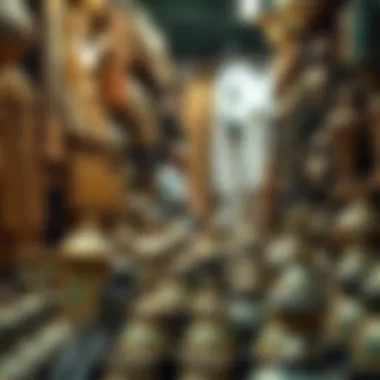

Balancing modernization with preservation is akin to walking a tightrope. On one hand, the demand for contemporary amenities and infrastructure is on the rise, fueled by a growing population and evolving market expectations. Shoppers today expect convenience, technology, and comfort. On the other hand, there is a deep-rooted sentiment toward conserving the unique historical essence of the market, which offers a distinct character that can't be replicated.
Efforts to modernize the market could include improved accessibility, enhanced security, and the introduction of digital payment solutions. These enhancements could make the market more appealing to a younger, tech-savvy demographic. Yet, implementing these changes could lead to the dilution of the market's traditional charm, leaving long-time visitors feeling disconnected from its origins.
- Considerations for Investors: When looking to invest in the Old Dubai Market, one must consider how potential developments will mesh with the existing architectural styles and cultural significance.
- Creative Solutions: Engaging local artisans in modernization projects can help bridge this gap, ensuring that new developments honor the market's heritage while providing modern services.
Economic Pressures
Economic pressures are a constant cloud hovering over the Old Dubai Market. As surrounding skyscrapers and shopping malls rise, the competition becomes increasingly fierce. These commercial behemoths not only draw away foot traffic but also create a perception that the market is less appealing.
Several factors contribute to the economic pressures faced by the Old Dubai Market:
- Changing Consumer Preferences: Today's consumers favor one-stop shopping experiences, often gravitating toward larger malls that offer all services under one roof. This trend presents a substantial challenge for traditional souks, which depend on their unique offerings and charm.
- High Rental Costs: As Dubai evolves, the cost of renting space within the Old Dubai Market has escalated. Local vendors find it increasingly harder to sustain their businesses amidst rising expenses. Many small shop owners are grappling with tighter margins, threatening the diversity of products available in the market.
"In the face of modernization, the Old Dubai Market must find ways to stay relevant, preserving its traditional appeal while navigating economic realities."
To sum, the Old Dubai Market's challenges encompass the need for balance between progress and preservation, alongside navigating economic hurdles that threaten its traditional business model. Addressing these issues head-on will be crucial for maintaining the market's unique identity while adapting to the modern age.
Future Prospects
The future of the Old Dubai Market holds immense significance for the economic and cultural landscape of the city. As the market navigates the waters of modern advancement, it faces the delicate balance between maintaining its rich history and adapting to the ever-changing needs of its visitors and residents. This section delves into two critical components of the market's future: the planned developments that could reshape its structural and commercial offerings, and the sustainability initiatives aimed at preserving its charm while promoting environmental responsibility.
Planned Developments
Investments in the Old Dubai Market are poised to introduce new facilities and enhance existing structures, thereby making it an even more attractive destination. Proposed developments often embody a blend of innovation and tradition, ensuring that while the market evolves, it does not lose the essence that makes it unique. For instance, the renovation of heritage sites, like the Deira Souk, can offer modern amenities while preserving their original architectural styles.
Potential projects might include:
- New retail spaces: Developing shopping areas that showcase both traditional crafts and contemporary merchandise, catering to a diverse clientele.
- Enhancements in public amenities: Improving accessibility, such as adding ramps and better signage, can make the market easily navigable for all.
- Cultural centers: Establishing spaces where visitors can learn about the history and traditions of the local artisans, enhancing educational opportunities.
These planned developments intend to ensure that the Old Dubai Market remains a vital hub for commerce as well as a cultural beacon.
Sustainability Initiatives
The emphasis on sustainability is gaining momentum worldwide, and the Old Dubai Market is no exception. Sustainable practices not only preserve the environment but also enhance the market’s appeal, particularly among eco-conscious visitors. Adopting such practices can lead to a significant transformation in how the market operates.
Several potential initiatives include:
- Waste reduction programs: Implementing robust recycling systems and promoting biodegradable products among vendors.
- Energy-efficient operations: Retrofitting existing buildings with solar panels or energy-efficient lighting to lessen the carbon footprint.
- Community engagement: Involving local businesses and artisans in discussions about sustainable practices to foster a sense of collective responsibility.
“Sustainability isn’t just about saving the planet; it’s about creating a lucrative future that respects our past.”
Through these sustainability initiatives, the Old Dubai Market can enhance its attractiveness while ensuring that future generations can enjoy its rich heritage.
Finale
In the tapestry of Dubai's rapid evolution, the Old Dubai Market stands out as a thread of cultural significance that interweaves tradition with the pulse of modernity. Understanding this market encapsulates its historical stature and enduring impact on both local and global stages. The combination of its rich heritage, unique offerings, and the role it plays in shaping Dubai's identity cannot be overstated.
Recap of the Market's Significance
The Old Dubai Market is not merely a place to shop but a living museum where visitors can witness the vibrant exchange of goods and cultures. Traditionally, it has served as a hub for traders and artisans, showcasing everything from spices to textiles. Its continued relevance speaks volumes about how a marketplace can sustain a way of life while adapting to contemporary demands. Importantly, this market serves both as a commercial center and a cultural sanctuary, regularly hosting events that celebrate local customs and arts.
- Interconnectedness: The Old Dubai Market links the past with the present, providing insights into the Emirates' trading history.
- Economic Catalyst: The interactions fostered here contribute significantly to the city's economy, further solidifying its status as a global metropolis.
- Cultural Richness: The market's architecture and the stories etched in its alleys resonate with both locals and tourists, making it a pivotal point for cultural exchange.
Thus, investing in this historical landmark isn't just about financial gain; it’s about contributing to a legacy that transcends mere commerce.
Call to Action for Investors and Visitors
For investors, the Old Dubai Market presents a unique opportunity, blending economic strategic advantages with cultural enrichment. Consider the benefits of investing here:
- Diverse Offerings: Investors can tap into a wide array of potential ventures, expanding retail, dining, and hospitality avenues in a locale rich in history.
- Tourist Attraction: With millions flocking to Dubai annually, the market serves as an essential stopover, drawing in foot traffic that translates into profits for savvy entrepreneurs.
- Cultural Authenticity: Projects that respect the market's historical significance while incorporating modern enhancements can garner local and expatriate support, ensuring long-term success.
Visitors are encouraged to partake in this vibrant atmosphere, whether for the thrill of bargaining in souks or to simply enjoy a cup of traditional Arabic coffee at a local café. The Old Dubai Market invites everyone to experience its stories, flavors, and colors.
Engagement with this market, as both a visitor and an investor, fosters a deeper connection to Dubai’s legacy. Not only does it promise a substantial return on investment, but it secures a place in this city's ongoing narrative.
"To experience the Old Dubai Market is to walk through the pages of a living history, where each item has a story, and every corner whispers tales of a rich heritage."
As such, whether you’re looking to invest, explore, or simply broaden your horizons, the Old Dubai Market beckons with open arms and a promise of discovery.




